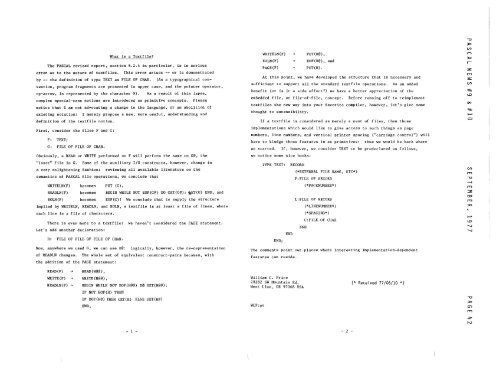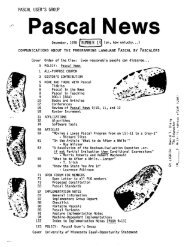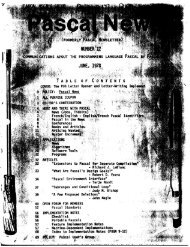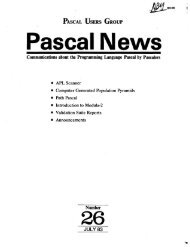Newsletter #9-#10 - Moorecad.com
Newsletter #9-#10 - Moorecad.com
Newsletter #9-#10 - Moorecad.com
You also want an ePaper? Increase the reach of your titles
YUMPU automatically turns print PDFs into web optimized ePapers that Google loves.
What is a Textfile?<br />
The PASCAL revised report, section 6.2.4 in particular, is in serious<br />
error as to the nature of textfiles.<br />
by -- the definition of type TEXT as FILE OF CHAR.<br />
This error arises -- or is demonstrated<br />
(As a typographicalconvention,<br />
program fragments are presented in upper case, and the pointer operator,<br />
up-arrow, is representedby the character @).<br />
As a result of this lapse,<br />
<strong>com</strong>plex special-casenotions are introduced as primitive concepts. Please<br />
notice that I am not advocating a change in the language, or an abolition of<br />
existing notation:<br />
definition of the textfile notion.<br />
First, consider the files F and G:<br />
F: TEXT;<br />
G: FILE OF FILE OF CHAR.<br />
I merely propose a new, more useful, understanding and<br />
Obviously, a READ or WRITE performed on F will perform the same on G@, the<br />
"inner" file in G. Some of the auxiliary r/o constructs, however~ change in<br />
a very enlightening fashion: reviewing all available literature on the<br />
semantics<br />
of PASCAL file operations, we conclude that<br />
WRITELN(F)<br />
READLN(F)<br />
EOLN(F)<br />
be<strong>com</strong>es<br />
be<strong>com</strong>es<br />
bec ames<br />
PUT (G),<br />
BEGIN WHILE NOT EOF(G@) DO GET(G@): ~ET(G) END, and<br />
EOF(G)!<br />
implied by WRITELN, READLN, and EOLN, a<br />
each line is a file of characters.<br />
We conclude that to supply the structure<br />
textfile is at least a file of lines, where<br />
There is even more to a textfile: we haven't considered the PAGE statement.<br />
Let's add another<br />
declaration:<br />
H: FILE OF FILE. OF FILE OF CHAR.<br />
Now, anywhere we used G, we can use H@:<br />
of READLNchanges.<br />
the addition of the PAGE statement:<br />
logically, however, the re-representation<br />
The wholeset of equivalentconstruct-pairs be<strong>com</strong>es,with<br />
WRITELN(F)<br />
EOLN(F)<br />
PAGE(F)<br />
PUT(H@),<br />
EOF(H@),.and<br />
PUT(H).<br />
At this point, we have developed the structure that is necessary and<br />
sufficient to support all the standard textfile operations. As an added<br />
benefit (or is it a side effect?) we have a better appreciation of the<br />
embedded file, or file-of-file, concept. Before running off to reimplement<br />
textfiles the new way into your favorite <strong>com</strong>piler, however, let's give some<br />
thought to extensibility.<br />
If a textfile is considered as merely a nest of files, then those<br />
implementations which would like to give access to such things as page<br />
numbers, line numbers, and vertical printer spacing ("carriage control") will<br />
have to kludge those features in as primitives: thus we would be back where<br />
we started. If, however, we consider TEXT to be predeclared as follows,<br />
we notice some nice hooks:<br />
TYPE TEXT: RECORD<br />
END;<br />
END<br />
(*EXTERNAL FILE NAME, ETC*)<br />
P :FILE OF RECORD<br />
(*PAGENUMBER*)<br />
L:FILE OF RECORD<br />
END<br />
(*LINENUMBER*)<br />
(*SPACING*)<br />
C:FILE OF CHAR<br />
The <strong>com</strong>ments point out places where interesting implementation-dependent<br />
features caD reside.<br />
READ (F) .;.<br />
WRITE (F)<br />
READLN(F)<br />
READ(H@@),<br />
WRITE(H@@),<br />
BEGIN WHILE NOT EOF(H@@) D0 GET(H@@):<br />
IF NOT EOF(H) THEN<br />
William C. Price<br />
28282 SW Mountain Rd.<br />
West Linn, OR 97068 USA<br />
(* Received 77/06/10 *)<br />
IF EOF(H@) THEN GET(H) ELSE GET(H@)<br />
END,<br />
WCP:pt<br />
- 1 -<br />
- 2 -






